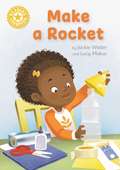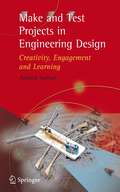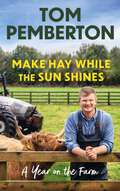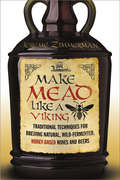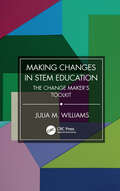- Table View
- List View
Major Infrastructure Projects: Planning for Delivery
by Edward Ochieng Andrew Price David MooreIn this unique and comprehensive textbook, the authors examine the challenges faced all around the world with regard to major infrastructure project management, and they champion a fresh approach that takes into account the interdependencies between economic, social, political, technological and legislative environments. Managing, developing and investing in crucial infrastructure is essential to keep up with the challenges of a fast-paced and globalised world, but affecting and overseeing change requires a deep understanding of complex interlocking systems. To this end the book is neatly divided into three key parts: project appraisal, maximising integrated supply chains, and implementing value-enhancing practices.This is the ideal companion for courses on any aspect of civil engineering and construction project management including modules in infrastructure planning, infrastructure management, construction management and business management. The book will also appeal to practitioners involved in the management of capital and infrastructure projects.
Major Label Mastering: Professional Mastering Process
by Evren GöknarMajor Label Mastering: Professional Mastering Process distills 25 years of mastering experience at Capitol Records into practical understandings and reliable systems. Containing unparalleled insights, this book reveals the mastering tricks and techniques used by Evren Göknar at one of the world’s most notable record labels. Beginning with the requisite competencies every Mastering Engineer must develop, Major Label Mastering delves into the particulars of the mastering studio, as well as fundamental mastering tools. Included among these tools is The Five Step Mastering Process, a rigorously tested system that equips the practitioner to successfully and confidently master a project to exacting standards of audio fidelity. Covering all bases, the book discusses both macro and micro considerations: from mindset approach and connecting with clients down to detailed guidelines for processing audio, advanced methods, and audio restoration. Each chapter ends with exercises intended to deepen understanding and skill, or to supplement course study. Suitable for all levels, this is a unique resource for students, artists, and recording and Mastering Engineers alike. Major Label Mastering is supplemented by digital resources including audio examples and video tutorials.
Major Label Mastering: Professional Mastering Process
by Evren GöknarMajor Label Mastering: Professional Mastering Process distills 25 years of mastering experience at Capitol Records into practical understandings and reliable systems. Containing unparalleled insights, this book reveals the mastering tricks and techniques used by Evren Göknar at one of the world’s most notable record labels. Beginning with the requisite competencies every Mastering Engineer must develop, Major Label Mastering delves into the particulars of the mastering studio, as well as fundamental mastering tools. Included among these tools is The Five Step Mastering Process, a rigorously tested system that equips the practitioner to successfully and confidently master a project to exacting standards of audio fidelity. Covering all bases, the book discusses both macro and micro considerations: from mindset approach and connecting with clients down to detailed guidelines for processing audio, advanced methods, and audio restoration. Each chapter ends with exercises intended to deepen understanding and skill, or to supplement course study. Suitable for all levels, this is a unique resource for students, artists, and recording and Mastering Engineers alike. Major Label Mastering is supplemented by digital resources including audio examples and video tutorials.
Major Research Topics in Combustion (ICASE NASA LaRC Series)
by M. Y. Hussaini A. Kumar R. G. VoigtThe Institute for Computer Applications in Science and Engineer ing (ICASE) and NASA Langley Research Center (LaRC) brought together on October 2-4, 1989 experts in the various areas of com bustion with a view to expose them to some combustion problems of technological interest to LaRC and possibly foster interaction with the academic community in these research areas. The top ics chosen for this purpose were flame structure, flame stability, flame holding/extinction, chemical kinetics, turbulence-kinetics in teraction, transition to detonation, and reacting free shear layers. The lead paper set the stage by discussing the status and issues of supersonic combustion relevant to scramjet engine. Then the ex perts were called upon i) to review the current status of knowledge in the aforementioned ;:I. reas, ii) to focus on how this knowledge can be extended and applied to high-speed combustion, and iii) to suggest future directions of research in these areas. Each topic was then dealt with in a position paper followed by formal discussion papers and a general discussion involving the participants. The position papers discussed the state-of-the-art with an emphasis on key issues that needed to be resolved in the near future. The discussion papers crit ically examined these issues and filled in any lacunae therein. The edited versions of the general discussions in the form of questions from the audience and answers from the speakers are included wher ever possible to give the reader the flavor of the lively interactions that took place.
Major Thomas
by Greg GrowdenOpinion is still sharply divided on whether Breaker Morant and his Australian co-defendants were criminals who got what they deserved, or scapegoats used by the British Empire. Major Thomas, the bush lawyer drafted in at the last minute to defend them, is invariably depicted as either a hero or an incompetent fool. Now, for the first time, Greg Growden attempts to unravel the truth about the lawyer and soldier who returned from South Africa a broken man. Before the Boer War, Major Thomas had been a pillar of his community. He was a published poet, newspaper proprietor, lawyer and decorated soldier, but defending Breaker Morant became the defining episode of his life. The former ‘King of Tenterfield’ endured a stunning fall from grace, slipping into bankruptcy and imprisonment. Thomas ended his days as an eccentric recluse, his life ruined by the ignominy and frustration of finding himself on the wrong side of history. For more than a century he has been a footnote in diverging historical arguments. A proper hearing for Major Thomas is long overdue.
Make a Rocket: Independent Reading Yellow 3 (Reading Champion #515)
by Jackie WalterNo synopsis available.
Make and Test Projects in Engineering Design: Creativity, Engagement and Learning
by Andrew E. SamuelMake and test projects are used as introductory design experiences in almost every engineering educational institution world wide. However, the educational benefits and costs associated with these projects have been seldom examined. Make and Test Projects in Engineering Design provides a serious examination of the design of make and test projects and their associated educational values. A taxonomy is provided for the design of make and test projects as well as a catalogue of technical information about unconventional engineering materials and energy sources. Case studies are included based on the author’s experience of supervising make and test projects for over twenty-five years. The book is aimed at the engineering educator and all those planning and conducting make and test projects. Up until now, this topic has been dealt with informally. Make and Test Projects in Engineering Design is the first book that formalises this important aspect of early learning in engineering design. It will be an invaluable teaching tool and resource for educators in engineering design.
Make Hay While the Sun Shines: A Year on the Farm
by Tom Pemberton*A Sunday Times Bestseller*For five generations, the Pemberton family have farmed at Birks Farm in the picturesque town of Lytham on Lancashire's Fylde Coast, working at the heart of the area since the 1830s and supplying dairy produce to the local community ever since. In 2016, Tom Pemberton uploaded a one-minute video to YouTube about how to use the farm shop's new raw milk vending machine. He thought a handful of people would watch it. It turns out many more did. And so he began uploading regular videos, every Tuesday, Friday and the occasional Sunday to show what he gets up to on the farm. Things don't always go to plan, especially when you're the farmer's son, but every day's a learning day and Tom approaches work as he does life in general: stay positive and don't take yourself too seriously. Make Hay While the Sun Shines takes us behind the farm gate and follows a year on the farm: from calving to maintaining machinery, from mucking out to planning and building a brand-new cow shed. Tom gives us a unique insight into everyday life on a busy dairy farm with all its highs, lows and hard graft. Full of heart, amusing anecdotes and unforgettable characters like Tom's dad, Andy - aka the Ginger Warrior - this is Tom's story of determination, adventure and how to keep a smile on your face even when you're knee-deep in cow poo.
Make It Rain: State Control of the Atmosphere in Twentieth-Century America
by Kristine C. HarperWeather control. Juxtaposing those two words is enough to raise eyebrows in a world where even the best weather models still fail to nail every forecast, and when the effects of climate change on sea level height, seasonal averages of weather phenomena, and biological behavior are being watched with interest by all, regardless of political or scientific persuasion. But between the late nineteenth century—when the United States first funded an attempt to “shock” rain out of clouds—and the late 1940s, rainmaking (as it had been known) became weather control. And then things got out of control. In Make It Rain, Kristine C. Harper tells the long and somewhat ludicrous history of state-funded attempts to manage, manipulate, and deploy the weather in America. Harper shows that governments from the federal to the local became helplessly captivated by the idea that weather control could promote agriculture, health, industrial output, and economic growth at home, or even be used as a military weapon and diplomatic tool abroad. Clear fog for landing aircraft? There’s a project for that. Gentle rain for strawberries? Let’s do it! Enhanced snowpacks for hydroelectric utilities? Check. The heyday of these weather control programs came during the Cold War, as the atmosphere came to be seen as something to be defended, weaponized, and manipulated. Yet Harper demonstrates that today there are clear implications for our attempts to solve the problems of climate change.
Make Mead Like a Viking: Traditional Techniques for Brewing Natural, Wild-Fermented, Honey-Based Wines and Beers
by Jereme ZimmermanA complete guide to using the best ingredients and minimal equipment to create fun and flavorful brews Ancient societies brewed flavorful and healing meads, ales, and wines for millennia using only intuition, storytelling, and knowledge passed down through generations—no fancy, expensive equipment or degrees in chemistry needed. In Make Mead Like a Viking, homesteader, fermentation enthusiast, and self-described “Appalachian Yeti Viking” Jereme Zimmerman summons the bryggjemann of the ancient Norse to demonstrate how homebrewing mead—arguably the world’s oldest fermented alcoholic beverage—can be not only uncomplicated but fun. Armed with wild-yeast-bearing totem sticks, readers will learn techniques for brewing sweet, semi-sweet, and dry meads, melomels (fruit meads), metheglins (spiced meads), Ethiopian t’ej, flower and herbal meads, braggots, honey beers, country wines, and even Viking grog, opening the Mead Hall doors to further experimentation in fermentation and flavor. In addition, aspiring Vikings will explore: • The importance of local and unpasteurized honey for both flavor and health benefits; • Why modern homebrewing practices, materials, and chemicals work but aren’t necessary; • How to grow and harvest herbs and collect wild botanicals for use in healing, nutritious, and magical meads, beers, and wines; • Hops’ recent monopoly as a primary brewing ingredient and how to use botanicals other than hops for flavoring and preserving mead, ancient ales, and gruits; • The rituals, mysticism, and communion with nature that were integral components of ancient brewing and can be for modern homebrewers, as well; • Recommendations for starting a mead circle to share your wild meads with other brewers as part of the growing mead-movement subculture; and more! Whether you’ve been intimidated by modern homebrewing’s cost or seeming complexity in the past—and its focus on the use of unnatural chemicals—or are boldly looking to expand your current brewing and fermentation practices, Zimmerman’s welcoming style and spirit will usher you into exciting new territory. Grounded in history and mythology, but—like Odin’s ever-seeking eye—focusing continually on the future of self-sufficient food culture, Make Mead Like a Viking is a practical and entertaining guide for the ages.
Make, Think, Imagine: Engineering the Future of Civilisation
by John Browne'An ode to the ways in which engineering has improved human civilisation' John Hennessy, Chairman, Alphabet'A blueprint for future global progress underpinned by the spirit of innovation' Lord Foster, architectToday's unprecedented pace of change leaves many people wondering what new technologies are doing to our lives. Has social media robbed us of our privacy and fed us with false information? Are the decisions about our health, security and finances made by computer programs inexplicable and biased? Will these algorithms become so complex that we can no longer control them? Are robots going to take our jobs? Will better healthcare lead to an ageing population which cannot be cared for? Can we provide housing for our ever-growing urban populations? Will we all be terrorised by autonomous drones that can identify and kill us, one by one? And has our demand for energy driven the Earth's climate to the edge of catastrophe?John Browne argues that we need not and must not put the brakes on technological advance. Civilisation is founded on engineering innovation; all progress stems from the human urge to make things and to shape the world around us, resulting in greater freedom, health and wealth for all. Drawing on history, his own experiences and conversations with many of today's great innovators, he uncovers the basis for all progress and its consequences, both good and bad. He argues compellingly that the same spark that triggers each innovation can be used to counter its negative consequences. Make, Think, Imagine provides an eloquent blueprint for how we can keep moving towards a brighter future.
Make-to-Order Assembly Management
by Rainer KolischPurchasing .Fabrication Assembly Distribution Figure 1.1: Multi-Level Manufacturing System for Make-to-Order Products specific resources of a type, i.e., a certain machine or a single worker, the determination of the sequence operations are processed on a ma chine, and the assignment of start and finish times to operations. We will modify this framework to be specifically suited for multi level make-to-order manufacturing systems. We assume that the facil ity design issue is settled, i.e., the location and the layout of the facility as well as the capacity ofthe three main resource types of the company are determined. These resource types are the engineering department, the fabrication department, and the assembly department. The engineering department is concerned with the construction of new products as well as the modification and customization of ex isting products. This entails the generation of engineering documents such as blue prints for manufacturing. The capacity of the engineering department is determined by the the count and qualification of engi neers and by the availability of construction devices such as computer aided design (CAD) systems etc.
Make Way for the Superhumans: How the science of bio enhancement is transforming our world, and how we need to deal with it
by Michael BessBiomedical research is changing the both the format and the functions of human beings. Very soon the human race will be faced with a choice: do we join in with the enhancement or not? Make Way for the Superhumans looks at how far this technology has come and what aims and ambitions it has. From robotic implants that restore sight to the blind, to performance enhancing drugs that build muscles, improve concentration, and maintain erections, bio-enhancement has already made massive advances. Humans have already developed the technology to transmit thoughts and actions brain-to-brain using only a computer interface. By the time our grandchildren are born, they will be presented with the option to significantly alter and redesign their bodies. Make Way for the Superhumans is the only book that poses the questions that need answering now: suggesting real, practical ways of dealing with this technology before it reaches a point where it can no longer be controlled.
Make Your Business a Lean Business: How to Create Enduring Market Leadership
by Paul C. Husby Jerome HamiltonMake Your Business a Lean Business is a written by business leaders for business leaders as a how-to guide to building enduring market leadership. Written by authors with more than 60 years’ experience applying Lean to operations and businesses, this book will allow readers to understand Lean principles and apply practices to transform their business. It also Shows readers how to transform their business to a Lean business using Lean philosophy, values, practice, and tools Is a comprehensive Lean Enterprise Operational Management System implementation guide that defines the Lean Enterprise Business Model Uses personal author experiences throughout the book to illuminate and reinforce concepts and practices Provides insights and a roadmap so executives can take immediate action to start building a Lean business Readers will be able follow a logical path aligning their business from strategy to detailed activity, thereby engaging their entire organization in becoming more competitive. It is the only true enterprise book about applying Lean to the entire business, and it provides business leaders with the understanding, approach, and tools to plan, align, and transform their business starting with their core business value proposition, business planning, disciplined goal and resource alignment, and implementation management.
Make Your Business a Lean Business: How to Create Enduring Market Leadership
by Paul C. Husby Jerome HamiltonMake Your Business a Lean Business is a written by business leaders for business leaders as a how-to guide to building enduring market leadership. Written by authors with more than 60 years’ experience applying Lean to operations and businesses, this book will allow readers to understand Lean principles and apply practices to transform their business. It also Shows readers how to transform their business to a Lean business using Lean philosophy, values, practice, and tools Is a comprehensive Lean Enterprise Operational Management System implementation guide that defines the Lean Enterprise Business Model Uses personal author experiences throughout the book to illuminate and reinforce concepts and practices Provides insights and a roadmap so executives can take immediate action to start building a Lean business Readers will be able follow a logical path aligning their business from strategy to detailed activity, thereby engaging their entire organization in becoming more competitive. It is the only true enterprise book about applying Lean to the entire business, and it provides business leaders with the understanding, approach, and tools to plan, align, and transform their business starting with their core business value proposition, business planning, disciplined goal and resource alignment, and implementation management.
Makers at School, Educational Robotics and Innovative Learning Environments: Research and Experiences from FabLearn Italy 2019, in the Italian Schools and Beyond (Lecture Notes in Networks and Systems #240)
by David Scaradozzi Lorenzo Guasti Margherita Di Stasio Beatrice Miotti Andrea Monteriù Paulo BliksteinThis open access book contains observations, outlines, and analyses of educational robotics methodologies and activities, and developments in the field of educational robotics emerging from the findings presented at FabLearn Italy 2019, the international conference that brought together researchers, teachers, educators and practitioners to discuss the principles of Making and educational robotics in formal, non-formal and informal education.The editors’ analysis of these extended versions of papers presented at FabLearn Italy 2019 highlight the latest findings on learning models based on Making and educational robotics. The authors investigate how innovative educational tools and methodologies can support a novel, more effective and more inclusive learner-centered approach to education. The following key topics are the focus of discussion: Makerspaces and Fab Labs in schools, a maker approach to teaching and learning; laboratory teaching and the maker approach, models, methods and instruments; curricular and non-curricular robotics in formal, non-formal and informal education; social and assistive robotics in education; the effect of innovative spaces and learning environments on the innovation of teaching, good practices and pilot projects.
Making a Difference: The Proceedings of the Seventh International Conference of the Learning Sciences (ICLS)
by Sasha A. Barab Kenneth E. Hay Daniel T. HickeyFirst published in 2006. Routledge is an imprint of Taylor & Francis, an informa company.
Making a Difference: The Proceedings of the Seventh International Conference of the Learning Sciences (ICLS)
by Sasha A. Barab Kenneth E. Hay Nancy Butler Songer Daniel T. HickeyFirst published in 2006. Routledge is an imprint of Taylor & Francis, an informa company.
Making a Good Life: An Ethnography of Nature, Ethics, and Reproduction
by Katharine DowMaking a Good Life takes a timely look at the ideas and values that inform how people think about reproduction and assisted reproductive technologies. In an era of heightened scrutiny about parenting and reproduction, fears about environmental degradation, and the rise of the biotechnology industry, Katharine Dow delves into the reproductive ethics of those who do not have a personal stake in assisted reproductive technologies, but who are building lives inspired and influenced by environmentalism and concerns about the natural world's future.Moving away from experiences of infertility treatments tied to the clinic and laboratory, Dow instead explores reproduction and assisted reproductive technologies as topics of public concern and debate, and she examines how people living in a coastal village in rural Scotland make ethical decisions and judgments about these matters. In particular, Dow engages with people's ideas about nature and naturalness, and how these relate to views about parenting and building stable environments for future generations. Taking into account the ways daily responsibilities and commitments are balanced with moral values, Dow suggests there is still much to uncover about reproductive ethics.Analyzing how ideas about reproduction intersect with wider ethical struggles, Making a Good Life offers a new approach to researching, thinking, and writing about nature, ethics, and reproduction.
Making a Good Life: An Ethnography of Nature, Ethics, and Reproduction
by Katharine DowMaking a Good Life takes a timely look at the ideas and values that inform how people think about reproduction and assisted reproductive technologies. In an era of heightened scrutiny about parenting and reproduction, fears about environmental degradation, and the rise of the biotechnology industry, Katharine Dow delves into the reproductive ethics of those who do not have a personal stake in assisted reproductive technologies, but who are building lives inspired and influenced by environmentalism and concerns about the natural world's future.Moving away from experiences of infertility treatments tied to the clinic and laboratory, Dow instead explores reproduction and assisted reproductive technologies as topics of public concern and debate, and she examines how people living in a coastal village in rural Scotland make ethical decisions and judgments about these matters. In particular, Dow engages with people's ideas about nature and naturalness, and how these relate to views about parenting and building stable environments for future generations. Taking into account the ways daily responsibilities and commitments are balanced with moral values, Dow suggests there is still much to uncover about reproductive ethics.Analyzing how ideas about reproduction intersect with wider ethical struggles, Making a Good Life offers a new approach to researching, thinking, and writing about nature, ethics, and reproduction.
Making a Semiconductor Superpower: The Seven Engineers from KAIST Who Shaped the Chip Industry
by Dong-Won KimThis book provides real stories about the South Korean semiconductor community. It explores the lives and careers of six influential semiconductor engineers who all studied at Korea Advanced Institute of Science and Technology (KAIST) under the mentorship of Dr. Kim Choong-Ki, the most influential semiconductor professor in South Korea during the last quarter of the twentieth century. Kim’s students became known as “Kim’s Mafia” because of the important positions they went on to hold in industry, government, and academia. This book will be of interest to semiconductor engineers and electronics engineers, historians of science and technology, and scholars and students of East Asian studies. “They were called ‘Kim’s Mafia.’ Kim Choong-Ki himself wouldn’t have put it that way. But it was true what semiconductor engineers in South Korea whispered about his former students: They were everywhere. … Kim was the first professor in South Korea to systematically teach semiconductor engineering. From 1975, when the nation had barely begun producing its first transistors, to 2008, when he retired from teaching, Kim trained more than 100 students, effectively creating the first two generations of South Korean semiconductor experts.” (Source: IEEE Spectrum, October, 2022.)
Making a Semiconductor Superpower: The Seven Engineers from KAIST Who Shaped the Chip Industry
by Dong-Won KimThis book provides real stories about the South Korean semiconductor community. It explores the lives and careers of six influential semiconductor engineers who all studied at Korea Advanced Institute of Science and Technology (KAIST) under the mentorship of Dr. Kim Choong-Ki, the most influential semiconductor professor in South Korea during the last quarter of the twentieth century. Kim’s students became known as “Kim’s Mafia” because of the important positions they went on to hold in industry, government, and academia. This book will be of interest to semiconductor engineers and electronics engineers, historians of science and technology, and scholars and students of East Asian studies. “They were called ‘Kim’s Mafia.’ Kim Choong-Ki himself wouldn’t have put it that way. But it was true what semiconductor engineers in South Korea whispered about his former students: They were everywhere. … Kim was the first professor in South Korea to systematically teach semiconductor engineering. From 1975, when the nation had barely begun producing its first transistors, to 2008, when he retired from teaching, Kim trained more than 100 students, effectively creating the first two generations of South Korean semiconductor experts.” (Source: IEEE Spectrum, October, 2022.)
Making Black Scientists: A Call to Action
by Marybeth Gasman Thai-Huy NguyenHistorically black colleges and universities are adept at training scientists. Marybeth Gasman and Thai-Huy Nguyen follow ten HBCU programs that have grown their student cohorts and improved performance. These science departments furnish a bold new model for other colleges that want to better serve African American students.
Making Changes in STEM Education: The Change Maker's Toolkit
by Julia M. WilliamsMany science, engineering, technology, and math (STEM) faculty wish to make an academic change at the course, department, college, or university level, but they lack the specific tools and training that can help them achieve the changes they desire. Making Changes in STEM Education: The Change Maker’s Toolkit is a practical guide based on academic change research and designed to equip STEM faculty and administrators with the skills necessary to accomplish their academic change goals. Each tool is categorized by a dominant theme in change work, such as opportunities for change, strategic vision, communication, teamwork, stakeholders, and partnerships, and is presented in context by the author, herself a change leader in STEM. In addition, the author provides interviews with STEM faculty and leaders who are engaged in their own change projects, offering additional insight into how the tools can be applied to a variety of educational contexts. The book is ideal for STEM faculty who are working to change their courses, curricula, departments, and campuses and STEM administrators who lead such change work to support their faculties, as well as graduate students in STEM who plan to enter an academic position upon graduation and expect to work on academic change projects.





